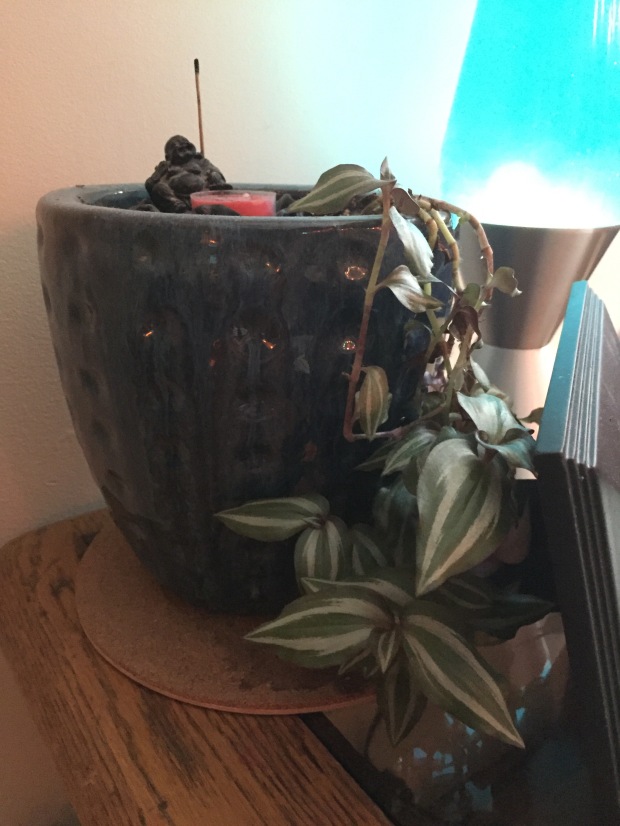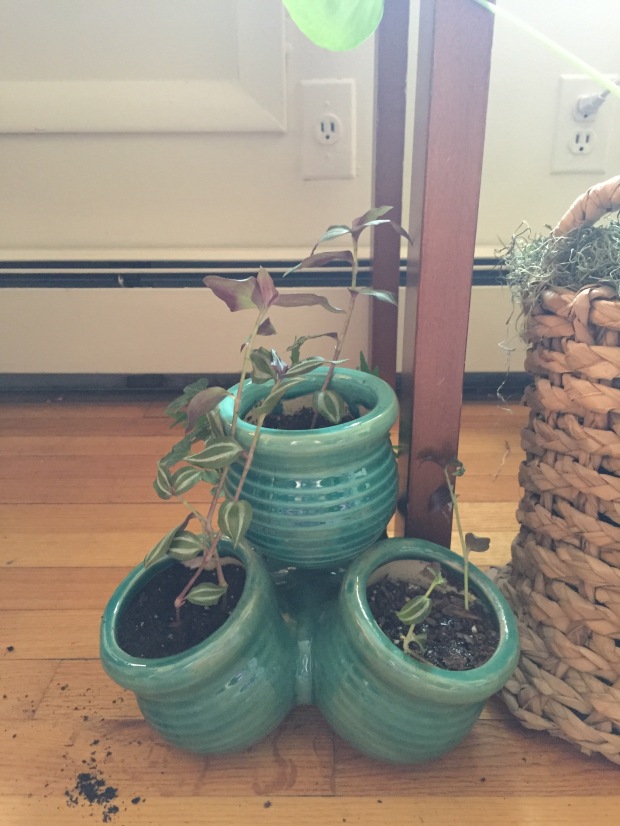Here is a semi-short summary of what I have been learning so far in my floral design distance course. All of the arrangements in this post are my own.
Module 1: Silk Flowers (fake flowers)
Round Arrangement & Centerpiece Arrangement
You would not believe the amount of work that goes into silk arrangements. You can’t just pick out the flowers and stick them into a piece of foam use it. You must remove each flower head (or lateral, which is a stem with multiple flower heads) and then use wax floral tape to attach it to an 18g wire. It sounds simple, but after attaching each flowerhead, leaf, or lateral to a wire, it is nearly impossible to use your hands for much else (which my instructor warned me about in the DVD). This lesson has by far been the most tedious. It took several days just for me to complete taping, and only about an hour to arrange both designs. The round arrangement (left) is my favorite of the two, although I like the draping of flowers on either side of the centerpiece (right). In Module 2 I similarly recreate each of these designs using fresh flowers.
Module 2: Fresh Flowers & Care
Round Arrangement & Centerpiece Arrangement
Technically both of these arrangements are centerpieces; both are meant to be viewed on all sides. I am only attaching one photo of each arrangement in this post because I want to keep this short, but also give you a good idea of what I’m doing here. Fresh flowers take much less preparation. The best way to keep your flowers as fresh as possible, make sure you cut off at least 1 1/2 – 2 inches of the stem at a sharp slanted angle, remove all leaves that will be below water level (these will rot and contaminate the water), change your water and add new preservative (if available to you), and cut off another inch of the stem. This will make sure your flowers can take up as much water and nutrients as possible. In these arrangements I used Oasis floral foam. To use it, all you have to do is fill a bucket or large bowl with water and preservative, set the desired sized block into the water, and let it absorb on its own. DON’T run water over it or it push it into the water, as this will create air bubbles inside and your blooms won’t get the necessary amount of water.
Module 3: Design Rules
Asymmetrical Design & Western Line Design
As you can see, the asymmetrical arrangement (left) is a pretty obvious right angle. These are often used to frame areas of focus in a room; maybe on top of a mantel around a painting or on either end of a table to frame the bride and groom at their dinner table during the reception. The western line design has an arm that slightly extends forward towards you. This is more subtle, but both have beautiful draping larkspur coming down to meet the table. In this lesson I learned about the Elements and Principles of Design. These are just as they were taught to me in high school. If you have taken any basic art class, you would learn these from the start. They are incredibly important when creating art, just as in creating a design. When you see an arrangement, think of it as a living sculpture. Someone put a lot of thought into the placement of each flower, even if it looks “effortlessly” beautiful.
Module 4: Pricing Techniques, Hospital Etiquette, Novelty Arrangements
Novelty Arrangement & Mug Arrangement
It’s hard to tell but the arrangement on left is in a small ceramic rocking horse, you can see a part of its bright yellow nose sticking out on the left side. I had to do this arrangement twice, as the first one was from the “front” of the container and disproportionate in height and width. This looks much better and my instructors were pleased. In this lesson I really learned what makes flowers so expensive. Wholesale is incredibly cheap, if you’re buying 25+ flowers, that’s the way to go. Unfortunately, no florist in their right mind would sell their flowers anywhere near that price. When you go to a florist, you could be spending anywhere from 2.5-7 times the actual cost of the flower, depending on your area and the availability. I also learned a lot about hospitals; certain areas won’t allow flowers at all, some will allow flowers but no balloons, and some will allow both. However, you should not send fragrant flowers such as lilies to a hospital because the rooms are only so big, and when someone isn’t feeling well, overwhelming smells can be nauseating. The hardest part of this lesson was probably making several bows. Just like with taping, my hands became cramped several times and I had to take a few breaks.
Module 5: Vases, Baskets, Flower Characteristics
Vase Arrangement & Basket Arrangement
I was happy to finally see a vase when I opened up my supply package that week; I have a lot of experience with foam and vases from when I worked as a florist at the grocery store, but hadn’t designed anything in a vase aside from the small arrangements in mason jars I would create with the leftover flowers from my other projects. It’s a big deal to make sure that each stem in the vase is clean and free of foliage, and cut on a steep slant so that it can take up the most water. They should all reach the bottom of vase, or come within at least an inch or two. The basket was also fun to work on, as this was the first design I got to choose on my own for my course. I could do an asymmetrical design (which is what I chose) or a round arrangement. My basket was a little taller, so I thought the asymmetrical could offer better balance.
If you have any questions about the types of flowers, techniques or just anything in general please comment and I’ll make a post describing my process, etc.!






















